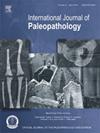An ‘Index of Oro-dental Disease’: A holistic method for understanding the impacts of different risk factors on oral health in archaeological populations
IF 1.5
3区 地球科学
Q3 PALEONTOLOGY
引用次数: 0
Abstract
Objective
To gain a more holistic understanding of oral health in the past by producing an ‘Index of Oro-dental Disease’ (IOD), incorporating multiple oro-dental diseases and accounting for differences in antemortem/postmortem alveolar bone and tooth loss.
Materials
UK Adult Dental Health Survey, 2009 anonymised dataset (N = 6206). Archaeological dental data from skeletal individuals from medieval and post-medieval Barton-upon-Humber, North Lincolnshire (N = 214, 1150–1855) and St James’s Gardens Burial Ground, London (N = 281, 1789–1853).
Methods
Creation of a formula for the production of index values. Application of the formula to clinical, ‘mock archaeological’, and archaeological datasets.
Results
Patterns in mean IOD values within different groups were identifiable regardless of preservation. It was possible to identify potential differences between IOD scores related to aging, tobacco consumption, geographical location, and time period.
Conclusions
Innovative use of modern clinical data and the production of ‘mock archaeological’ datasets provides validation of the IOD method. The approach may be useful for understanding the impact of different risk factors on oral health in the past, whilst also accounting for missing data and increasing comparability between groups.
Significance
Allows for the investigation of risk factors that affect overall oral health but manifest in different ways in different individuals, whilst also producing larger sample sizes.
Limitations
Impacts of age and posterior/anterior site positioning within the mouth suggest a careful consideration of age distribution and preservation of samples is required.
Future research
Future adaption and testing of the method on a greater range of population groups and different variables/risk factors for oro-dental disease.
“口腔-牙病指数”:了解不同危险因素对考古人群口腔健康影响的整体方法
目的通过编制“口腔-牙齿疾病指数”(IOD),综合多种口腔-牙齿疾病,并考虑死前/死后牙槽骨和牙齿脱落的差异,从而更全面地了解过去的口腔健康状况。资料suk成人牙齿健康调查,2009年匿名数据集(N = 6206)。考古牙齿数据来自中世纪和后中世纪亨伯河畔巴顿,北林肯郡(N = 214,1150 - 1855)和伦敦圣詹姆斯花园墓地(N = 281,1789 - 1853)的骨骼个体。方法建立一个公式,用于生产指标值。将公式应用于临床、“模拟考古”和考古数据集。结果无论保存与否,不同组内平均IOD值的变化规律均可识别。有可能确定与年龄、烟草消费、地理位置和时间段相关的IOD评分之间的潜在差异。现代临床数据的创新使用和“模拟考古”数据集的产生为IOD方法提供了验证。该方法可能有助于了解过去不同风险因素对口腔健康的影响,同时也可以解释缺失的数据并增加组间的可比性。意义允许调查影响整体口腔健康的风险因素,但在不同的个体中以不同的方式表现出来,同时也产生了更大的样本量。限制年龄和口腔内后/前位置的影响表明需要仔细考虑年龄分布和样品的保存。未来的研究该方法在更大范围的人群和不同的变量/口腔-牙病风险因素上的未来适应和测试。
本文章由计算机程序翻译,如有差异,请以英文原文为准。
求助全文
约1分钟内获得全文
求助全文
来源期刊

International Journal of Paleopathology
PALEONTOLOGY-PATHOLOGY
CiteScore
2.90
自引率
25.00%
发文量
43
期刊介绍:
Paleopathology is the study and application of methods and techniques for investigating diseases and related conditions from skeletal and soft tissue remains. The International Journal of Paleopathology (IJPP) will publish original and significant articles on human and animal (including hominids) disease, based upon the study of physical remains, including osseous, dental, and preserved soft tissues at a range of methodological levels, from direct observation to molecular, chemical, histological and radiographic analysis. Discussion of ways in which these methods can be applied to the reconstruction of health, disease and life histories in the past is central to the discipline, so the journal would also encourage papers covering interpretive and theoretical issues, and those that place the study of disease at the centre of a bioarchaeological or biocultural approach. Papers dealing with historical evidence relating to disease in the past (rather than history of medicine) will also be published. The journal will also accept significant studies that applied previously developed techniques to new materials, setting the research in the context of current debates on past human and animal health.
 求助内容:
求助内容: 应助结果提醒方式:
应助结果提醒方式:


